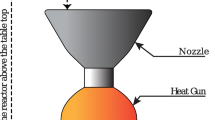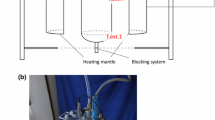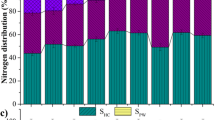Abstract
Municipal solid waste (MSW) disposal is one of the main issues towards sustainable development. Various technologies are studied to solve it. Hydrothermal carbonization (HTC) is an appropriate technology selection to reduce the waste volume primarily and to utilize MSW as the energy source because of its high the calorific value inside. This paper describes the potential of hydrochar production of raw materials in the provinces of East Java, Indonesia. The hydrochar production can be used as a secondary char and for electrical generation if it is combined with gasification process. The waste material affected the quality of combustion and calorific value to the product. The proximate and ultimate analysis using ASTM methods was conducted to analyze the characteristics of hydrochar. The influences of the HTC temperatures at saturated pressure (220°C, 23 bar) and variations of the feedstock moisture content (20–60%) were studied using a simulation of HTC process. The average calorific value of hydrochar is increased 32% of waste materials, 70% hydrochar yield, and 84% energy efficiency. This value indicates that the HTC process can produce hydrochar, moreover it reduced the mass of waste materials, also increased the energy content of products and the energy efficiency is a potential of energy generation from waste materials in an area.






Similar content being viewed by others
REFERENCES
Mayer, F., Bhandari, R., and Gath, S., Sci. Total Environ., 2019, vol. 672, p. 708. https://doi.org/10.1016/j.scitotenv.2019.03.449
Násner, A.M.L., Lora, E.E.S., Palacio, J.C.E., Rocha, M.H., Restrepo, J.C., Venturini, O.J., and Ratner, A., Waste Manag., 2017, vol. 69, p. 187. https://doi.org/10.1016/j.wasman.2017.08.006
Effat, H.A. and Hegazy, M.N., Egypt. J. Remote Sens. Sp. Sci., 2012, vol. 15, no. 2, p. 125. https://doi.org/10.1016/j.ejrs.2012.09.002
Zheng, X., Chen, W., Ying, Z., Huang, J., Ji, S., and Wang, B., Int. J. Hydrogen Energy, 2019, vol. 44, no. 21, p. 10374. https://doi.org/10.1016/j.ijhydene.2019.02.200
Gai, C., Chen, M., Liu, T., Peng, N., and Liu, Z., Energy, 2016, vol. 113, p. 957. https://doi.org/10.1016/j.energy.2016.07.129
Gai, C., Guo, Y., Liu, T., Peng, N., and Liu, Z., Int. J. Hydrogen Energy, 2016, vol. 41, no. 5, p. 3363. https://doi.org/10.1016/j.ijhydene.2015.12.188
Kamble, A.D., Saxena, V.K., Chavan, P.D., and Mendhe, V.A., Int. J. Min. Sci. Technol., 2019, vol. 29, no. 2, p. 171. https://doi.org/10.1016/j.ijmst.2018.03.011
Krysanova, K., Krylova, A., and Zaichenko, V., Fuel, 2019, vol. 256, p. 115929. https://doi.org/10.1016/j.fuel.2019.115929
Zheng, C., Ma, X., Yao, Z., and Chen, X., Biores. Technol., 2019, vol. 285, p. 121347. https://doi.org/10.1016/j.biortech.2019.121347
Lee, J., Sohn, D., Lee, K., and Park, K.Y., Chemosphere, 2019, vol. 230, p. 157. https://doi.org/10.1016/j.chemosphere.2019.05.066
Liu, T., Lang, Q., Xia, Y., Chen, Z., Li, D., Ma, J., Gai, C., and Liu, Z., Fuel, 2019. https://doi.org/10.1016/j.fuel.2019.01.035
Zheng, C., Ma, X., Yao, Z., and Chen, X., Biores., Technol., 2019. https://doi.org/10.1016/j.biortech.2019.121347
McGaughy, K. and Toufiq, Reza M., Biomass Convers. Biorefinery, 2018, vol. 8, no. 2, p. 283. https://doi.org/10.1007/s13399-017-0276-4
Khan, T.A., Saud, A.S., Jamari, S.S., Rahim, M.H.A., Park, J.-W., and Kim, H.-J., Biomass Bioenergy, 2019. https://doi.org/10.1016/j.biombioe.2019.105384
Heidari, M., Dutta, A., Acharya, B., and Mahmud, S., J. Energy Inst., 2018, p. 1. https://doi.org/10.1016/j.joei.2018.12.003
Liu, Z. and Balasubramanian, R., Appl. Energy, 2014, vol. 114, p. 857. https://doi.org/10.1016/j.apenergy.2013.06.027
Erlach, B., Harder, B., and Tsatsaronis, G., Proc. 24th Int. Conf. Effic. Cost, Optim. Simul. Environ. Impact Energy Syst. ECOS 2011, 2011, vol. 45, no. 1, p. 3642. https://doi.org/10.1016/j.energy.2012.01.057
Boumanchar, I., Chhiti, Y., M’hamdi, Alaoui F.E., El Ouinani, A., Sahibed-Dine, A., Bentiss, F., Jama, C., and Bensitel, M., Waste Manag., 2017, vol. 61, p. 78. https://doi.org/10.1016/j.wasman.2016.11.012
Gao, L., Volpe, M., Lucian, M., Fiori, L., and Goldfarb, J.L., Energy Convers. Manag., 2019. https://doi.org/10.1016/j.enconman.2018.12.009
Lucian, M., Volpe, M., Gao, L., Piro, G., Goldfarb, J.L., and Fiori, L., Fuel, 2018. https://doi.org/10.1016/j.fuel.2018.06.060
Lin, Y., Ma, X., Peng, X., and Yu, Z., Biores. Technol., 2017. https://doi.org/10.1016/j.biortech.2017.06.117
Kim, D., Park, K.Y., and Yoshikawa, K., Eng. Appl. Biochar., 2017. https://doi.org/10.5772/intechopen.68221
Reza, M.T., Uddin, M.H., Lynam, J.G., and Coronella, C.J., Biomass Bioenergy, 2014, vol. 63, p. 229. https://doi.org/10.1016/j.biombioe.2014.01.038
Zhao, P., Shen, Y., Ge, S., Chen, Z., and Yoshikawa, K., Appl. Energy, 2014, vol. 131, p. 345. https://doi.org/10.1016/j.apenergy.2014.06.038
Mäkelä, M., Forsberg, J., Söderberg, C., Larsson, S.H., and Dahl, O., Biores. Technol., 2018, vol. 263, p. 654. https://doi.org/10.1016/j.biortech.2018.05.044
Javadzadeh, Y. and Hamedeyaz, S., Trends Helicobacter pylori Infect., 2014, p. 13. https://doi.org/10.5772/57353
Zhu, G., Yang, L., Gao, Y., Xu, J., Chen, H., Zhu, Y., Wang, Y., Liao, C., Lu, C., and Zhu, C., Fuel, 2019, vol. 244, p. 479. https://doi.org/10.1016/j.fuel.2019.02.039
Steurer, E. and Ardissone, G., Energy Procedia, 2015, vol. 79, p. 47. https://doi.org/10.1016/j.egypro.2015.11.473
Tumuluru, J.S., Biomass Preprocessing and Pretreatments for Production of Biofuels, 2018.https://doi.org/10.1201/9781315153735
Basu, P., Biomass Gasification Design Handbook, Elsevier, 2010, p. 27. https://doi.org/10.1016/b978-0-12-374988-8.00002-7
Naderi, M. and Vesali-Naseh, M., Biomass Convers. Biorefinery, 2019. https://doi.org/10.1007/s13399-019-00513-2
Zornoza, R., Moreno-Barriga, F., Acosta, J.A., Mu-ñoz, M.A., and Faz, A., Chemosphere, 2016, vol. 144, p. 122. https://doi.org/10.1016/j.chemosphere.2015.08.046
Zhang, X., Zhang, L., and Li, A., J. Environ. Manage., 2017, vol. 201, p. 52. https://doi.org/10.1016/j.jenvman.2017.06.018
Khandelwal, H., Dhar, H., Thalla, A.K., and Kumar, S., J. Clean. Prod., 2019, vol. 209, p. 630. https://doi.org/10.1016/j.jclepro.2018.10.233
Dong, M., Mao, X., Gonzalez, J.J., Lu, J., and Russo, R.E., J. Anal. At. Spectrom., 2012, vol. 27, no. 12, p. 2066. https://doi.org/10.1039/c2ja30222e
Vassilev, S.V., Vassileva, C.G., and Vassilev, V.S., Fuel, 2015, vol. 158, p. 330. https://doi.org/10.1016/j.fuel.2015.05.050
Vassilev, S.V., Vassileva, C.G., Song, Y.C., Li, W.Y., and Feng, J., Fuel, 2017, vol. 208, p. 377. https://doi.org/10.1016/j.fuel.2017.07.036
ACKNOWLEDGMENTS
We would like to express our sincere thanks, gratitude and appreciations to LPPM ITS, for funding the current research under the scheme of Pascasarjana Research Grant 2019. We also would like to extend our appereciations to all members of Energy Engineering and Environmental Conditioning Laboratory, Department of Engineering Physics ITS for their enormous contributions to this work.
Author information
Authors and Affiliations
Corresponding author
Ethics declarations
The data that support the findings of this study are available from the corresponding author upon reasonable request.
About this article
Cite this article
Hantoro, R., Septyaningrum, E., Siswanto, B.B. et al. Hydrochar Production through the HTC Process: Case Study of Municipal Solid Waste Samples in East Java, Indonesia. Solid Fuel Chem. 54, 418–426 (2020). https://doi.org/10.3103/S036152192006004X
Received:
Revised:
Accepted:
Published:
Issue Date:
DOI: https://doi.org/10.3103/S036152192006004X




